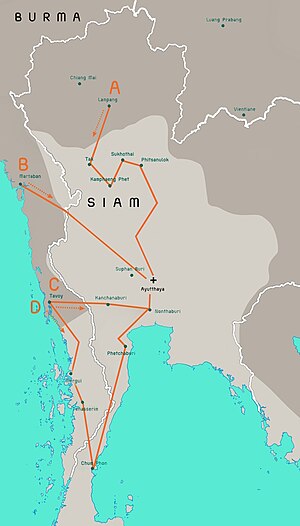Burmese–Siamese War (1765–1767)
| Burmese–Siamese War (1765–1767) | |||||||||
|---|---|---|---|---|---|---|---|---|---|
| Part of Burmese–Siamese wars | |||||||||

|
|||||||||
|
|||||||||
| Belligerents | |||||||||
|
|
|
||||||||
| Commanders and leaders | |||||||||
|
|
|
||||||||
| Units involved | |||||||||
|
|
|
||||||||
| Strength | |||||||||
|
Initial invasion force:
Nonthaburi: 20,000 |
Initial defenses:
Nonthaburi: 60,000 |
||||||||
![]() Royal Burmese Army including:
Royal Burmese Army including:
Initial invasion force:
40,000 to 50,000
Nonthaburi: 20,000
Outer Ayutthaya: 50,000
Initial defenses:
Nonthaburi: 60,000
Outer Ayutthaya: 50,000
1 British ship
The Burmese–Siamese War (1765–1767) (Burmese: ယိုးဒယား-မြန်မာစစ် (၁၇၆၅–၁၇၆၇); Thai: สงครามคราวเสียกรุงศรีอยุธยาครั้งที่สอง, lit. "war of the second fall of Ayutthaya") was the second military conflict between the Konbaung Dynasty of Burma (Myanmar) and the Ban Phlu Luang Dynasty of Siam (Thailand), and the war that ended the four-century-old Siamese kingdom. Nonetheless, the Burmese were soon forced to give up their hard-won gains when the Chinese invasions of their homeland forced a complete withdrawal by the end of 1767. A new Siamese dynasty, to which the current Thai monarchy traces its origins, emerged to reunify Siam by 1770.
This war was the continuation of the war of 1759–1760. The casus belli of this war was also the control of the Tenasserim coast and its trade, and the Siamese support for the rebels in the Burmese border regions. The war began in August 1765 when a 20,000-strong northern Burmese army invaded northern Siam, and was joined in by three southern armies of over 20,000 in October, in a pincer movement on Ayutthaya. By late January 1766, the Burmese armies had overcome numerically superior but poorly coordinated Siamese defences, and converged before the Siamese capital.
...
Wikipedia
